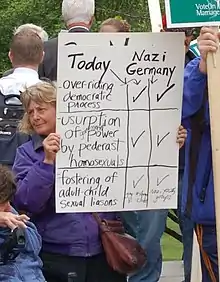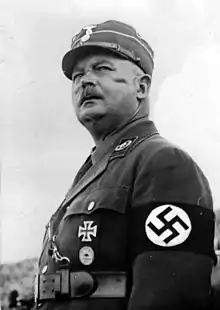Gay fascism
Gay fascism is the idea that homosexuals were numerous and prominent as a group in the Nazi Party[lower-alpha 1] or the identification of Nazism with homosexuality more generally.[lower-alpha 2] It has been promoted by various individuals and groups both before and after World War II, especially by left-wing Germans during the Nazi era[1] and the Christian right in the United States more recently.[4] Historians regard the claim as having no merit.[lower-alpha 3]

Background

In Nazi Germany, homosexuals were persecuted. About 100,000 were arrested, 50,000 convicted and some 5,000 to 15,000 interned in Nazi concentration camps, where they were forced to wear pink triangle badges. Some underwent castration or other Nazi human experimentation aimed at "curing" homosexuality. Adolf Hitler signed an edict that SS and police personnel would be subject to capital punishment if caught engaging in homosexual activity.[7][8]
According to Laurie Marhoefer, a small number of gay men belonged to a covert faction within the Nazi party that favored gay emancipation while denigrating feminists, Jews, and leftists.[9] Nazi propaganda asserted that "homosexual emancipation was a Jewish conspiracy to undermine the German Volk's morality".[10]
History
Origins
The myth is nearly as old as the Nazi party itself.[5] During Hitler's rise to power, some left-wing Germans seized on the homosexuality of well known Nazis, especially Ernst Röhm (commander of the Sturmabteilung (SA)), and tried to present homosexuality as widespread among Nazis in order to discredit them.[1] SA men were frequently greeted with shouts of Geil Röhm ("Hot Röhm!") or Schwul Heil ("Gay Heil").[11] Before World War II, both the Communist Party of Germany and the Social Democratic Party of Germany favored the repeal of Paragraph 175, the law criminalizing homosexuality between men, but they pragmatically used accusations of homosexuality to gain political advantage over their opponents.[12] In the Soviet Union, Maxim Gorky claimed that "Eradicate homosexuals and fascism will disappear".[13][14][15] Leftists, even those who were themselves gay, continued to hold an aversion to all non-monogamous or non-heterosexual sex. Gay antifascists had to stay in the closet in order to avoid rejection by their movement.[16]
Hitler exaggerated the homosexuality in the SA in order to justify the 1934 purge of the SA leadership (the Night of Long Knives).[17][18] According to British historian Daniel Siemens, it was the Nazis, not the left, who were most responsible for the lasting impression of the SA as homosexual.[11]
Other anti-Nazis, such as Kurt Tucholsky writing in the left-liberal Die Weltbühne in 1932, rejected the idea of attacking opponents for their personal lives.[11] German writer Klaus Mann (himself homosexual) wrote in a polemical essay, "'Vice' and the Left" (1934), that homosexuals had become the "Jews of the antifascists".[19] He also denounced the equation of the fascist Männerbund and homosexuality.[19][20] Mann concluded:
In the Third Reich gays are regularly being rounded up and put in work camps or even castrated and executed. Outside Germany they are derided in the leftist press and the German émigré community. We are at the point where homosexuals are being made scapegoats on all sides. In any case homosexuality is not going to be 'rooted out' and, if it were, it would leave civilization poorer.[21]
Although Mann was one of the most prominent intellectuals among exiled Germans, his essay was ignored.[19]
Germany's National Vice
In 1945, Samuel Igra, a German Jew who had spent the war in England,[22] published a book, Germany's National Vice, claiming that "there is a causal connection between mass sexual perversion" and German war crimes during both world wars.[23] This was a new element not present in the 1930s antifascist discourse.[22] Igra approvingly quoted British diplomat Robert Smallbones, who wrote in 1938 that "The explanation for this outbreak of sadistic cruelty may be that sexual perversion, in particular homo-sexuality, are very prevalent in Germany."[23] He argued that since both Judaism and Christianity have traditionally condemned homosexuality, "the Jews were the natural enemies of homosexual Nazi leaders such as Hitler and Röhm".[22] Igra wrote:
I think it is reasonable to hold that the psychological forces that let loose the sadistic orgies of the concentration camps, the mass murders in Germany, . . . and the subsequent atrocities in the occupied countries may be attributed mainly to one source and that this source is the moral perversion which was rampant among the Nazi leaders and which had its typical embodiment in Hitler himself.[24]
British scholar Gregory Woods describes Igra's book as "a sustained and obsessive pursuit of the myth of Fascistic homosexuality".[23] Igra's argument is undermined by his failure to explain the Nazi persecution of homosexuals or to justify his claim that homosexuality increases antisemitism. According to Woods, Igra's claims have "reappeared at regular intervals ever since the war".[23]
Postwar literature and film
Historian and sociologist Harry Oosterhuis identified the movies The Damned by Luchino Visconti (1969), The Conformist by Bernardo Bertolucci (1971), Salò or the 120 Days of Sodom by Pier Paolo Pasolini (1975), and The Tin Drum by Volker Schlöndorff (1978) as repeating the trope of a connection between homosexuality and Nazism. He also identifies Theodor W. Adorno, Maria Antonietta Macciocchi, and Reimut Reiche as writers who employ this trope. Susan Sontag also claimed that "there is a natural link" between fascism and sadomasochism between men.[25]
Anti-LGBT activism
.jpg.webp)
Pat Robertson also promoted the idea of gay Nazis, claiming that "Many of those people involved with Adolf Hitler were satanists. Many of them were homosexuals. The two seem to go together".[26] The idea was promoted in the 1995 book The Pink Swastika: Homosexuality in the Nazi Party by Scott Lively and Kevin Abrams.[4] The alleged connection between homosexuality and Nazism has attained some popularity on the American right,[4] being promoted by such groups as the American Family Association.[7] In 1993, the Family Research Institute sent out a newspaper asking "Was the Young Hitler a Homosexual Prostitute?", citing Igra's book as proof that Hitler was a homosexual before his rise to power.[27] The anti-gay advocacy group Oregon Citizens Alliance claimed:
Homosexuality was a CENTRAL element of the fascist system, that the Nazi elite was rampant with homosexuality and pederasty, that Adolph Hitler intentionally surrounded himself with homosexuals during his entire adult life, and that the people most responsible for many Nazi atrocities were homosexual.[28]
In 2015, statements that LGBT activists were "jack-booted homofascist thugs" and that Hitler was a homosexual were among the controversies that led to Republican National Committee official Bryan Fischer being fired.[29][30] Fischer also claimed that the Nazi party was founded at "a gay bar in Munich", that only Nazis who were "hardcore homosexuals" could advance in the party ranks, and that "Homosexual activists... [will] do the same thing to you that the Nazis did to their opponents in Nazi Germany".[31] During the 2015 Irish referendum on same-sex marriage, psychologist and No advocate Gerard van den Aardweg "claimed the Nazi party was 'rooted' in homosexuals".[32] In Death of a Nation, a 2018 film praised by Donald Trump Jr., Dinesh D'Souza claimed that Hitler did not persecute homosexuals in Nazi Germany.[33][34]
Reception
Historicity
American sociologist Arlene Stein acknowledges that there was a degree of homoeroticism in Nazi sports and physical culture, which was channeled into "militarism, brutality, and ideological fixations on powerful leadership figures". However, she asserts that this does not prove the revisionist claims. She notes that the Nazis "identified homosexuality with the emasculation of men", which threatened the traditional family praised in Nazi propaganda.[6] The German sociologist Erwin J. Haeberle wrote: "It is often assumed by casual students of Nazism that Hitler and many Nazi leaders were originally quite tolerant of homosexuality, that the entire SA leadership, for example, was homosexual, and that the intolerance set in only after the murder of Rohm and his friends in 1934. However, all these assumptions are false."[6]
Laurie Marhoefer concluded: "Although remarkably long-lived, mutable, capable of regenerating itself in various contexts, and even entertained at times by reputable historians, the myth of legions of gay Nazis has no historical basis".[5] Daniel Siemens listed Alexander Zinn, Jörn Meve, and Andreas Pretzel as writers on the historiography of gay Nazis who would agree with Marhoefer's statement.[11] Siemens added that there is no historical evidence to support the claim that the number of homosexuals in the SA exceeded their proportion in the population. He considers that it would be very surprising if that were the case, because of the Nazi persecution of homosexuals (from 1933) and denigration of homosexuality.[35]
According to American historian Andrew Wackerfuss in the book Stormtrooper Families, both Hitler and Lively endorsed the idea that there was a "sinister, scheming cult" within the SA which was "responsible for fascism’s excesses", but in fact homosexual SA members were located within broader heterosexual networks and were not especially evil.[2] Wackerfuss emphasizes that "The vast majority of homosexuals have been antifascist, while the vast majority of fascists have been heterosexuals", and that there is nothing inherently fascist about homosexuality or vice versa.[36] Writing in Journal of the History of Sexuality, Erik N. Jensen regards the linkage of homosexuality and Nazism as the recurrence of a "pernicious myth... long since dispelled" by "serious scholarship".[37][38] In the 1970s, gays and lesbians began to use the pink triangle as a symbol, partly as an attempt to rebut "the vicious, influential myth created by antifascists that Nazis were themselves, in some basic way, homosexual", in the words of historian Jonathan Ned Katz.[39][38] Historian Jonathan Zimmerman described the claim that "gay people helped bring Nazism to Germany" as "a flat-out lie".[7]
In 2014, German cultural historian Andreas Pretzel wrote that "The Fantasy Echo of gay Nazis, which has been used for decades to marginalize and discredit homosexual persecution, has largely faded away. The implicit allegation of the collective guilt of the persecuted homosexuals has thus become part of the history of the reception of the Nazi homosexual persecution."[40] In contrast, Siemens wrote in 2017 that "the cliché of the 'gay Nazi' is still firmly embedded in the cultural imagery of the Nazi movement".[11]
Purpose
Wackerfuss argues that by "equating sexual deviance and political deviance", readers can "rest comfortably in a naïve belief that their societies, their social circles, and they themselves can never fall into fascist temptations".[2] In his view, "the image of the gay Nazi therefore has very real consequences for modern politics" despite the rarity of actual gay Nazis.[41] According to Stein, contemporary proponents of the gay-Nazi theory on the religious right have four main goals:[42]
- strip gays of their "victim" status to decrease public support for LGBT rights
- drive a wedge between LGBT and Jewish voters, both traditionally progressive groups
- create a parallel between conservative Christians and Jews
- legitimize the idea that Christians are oppressed in the United States
Notes
- "In Western Europe as well as the Soviet Union, there was a general tendency among socialists in the 1930s to identify homosexuality with Nazism...The stereotype of homosexuality as a characteristic not just of individual Nazis but of the Nazi system as a whole was firmly established during three episodes: (1) the Röhm affair in 1931-32; (2) the Reichstag fire in 1933, when the destruction of the parliament building was followed by mass arrests of the Nazi regime’s political opponents; and (3) the so-called ‘‘Night of the Long Knives’’ or ‘‘Röhm putsch’’ in 1934, when a large number of the leaders of the SA (Sturmabteilung), the paramilitary troops of the Nazi party, were liquidated for political reasons."[3]
-
- "Although remarkably long-lived, mutable, capable of regenerating itself in various contexts, and even entertained at times by reputable historians, the myth of legions of gay Nazis has no historical basis."[5]
- Erwin J. Haeberle wrote: "It is often assumed by casual students of Nazism that Hitler and many Nazi leaders were originally quite tolerant of homosexuality, that the entire SA leadership, for example, was homosexual, and that the intolerance set in only after the murder of Rohm and his friends in 1934. However, all these assumptions are false."[6]
- The claim that "gay people helped bring Nazism to Germany... [is] a flat-out lie".[7]
References
- Oosterhuis 1995, p. 227.
- Wackerfuss 2015, p. 344.
- Oosterhuis 1995, pp. 227–228.
- Wackerfuss 2015, p. 341.
- Marhoefer 2015, p. 154.
- Stein 2016, p. 531.
- Zimmerman, Jonathan (August 27, 2011). "Did Nazis persecute gays, or were they gay themselves?". The Bakersfield Californian/History News Service. Archived from the original on 2012-05-27. Retrieved 2011-08-30.
- "Persecution of Homosexuals in the Third Reich". United States Holocaust Memorial Museum. Retrieved 9 January 2019.
- Marhoefer, Laurie (22 June 2017). "From gay Nazis to 'we're here, we're queer': A century of arguing about gay pride". The Conversation. Retrieved 13 April 2020.
- Marhoefer 2015, p. 152.
- Siemens 2017, p. 174.
- Oosterhuis 1995, p. 228.
- Lingiardi 2002, p. 90.
- Haggerty 2013, page.
- Spotts 2016, p. 94.
- Oosterhuis 1995, pp. 247–248.
- Siemens 2017, pp. 173–174.
- Fuhrer, Armin (28 February 2020). ""Geil Röhm" und " Schwul Heil": Hitler selbst formte den Mythos vom schwulen Nazi". FOCUS Online (in German). Retrieved 28 May 2020.
- Oosterhuis 1995, p. 247.
- Lingiardi 2002, pp. 90–91.
- Spotts 2016, pp. 95–96.
- Oosterhuis 1995, p. 244.
- Woods 1998, p. 251.
- Oosterhuis 1995, pp. 244–245.
- Oosterhuis 1995, p. 245.
- "Anti-Gay Religious Crusaders Claim Homosexuals Helped Mastermind the Holocaust". Southern Poverty Law Center. Retrieved 13 April 2020.
- Babits, Christopher (11 January 2017). "Finding Hitler (in All the Wrong Places?)". Not Even Past. Department of History at the University of Texas at Austin. Retrieved 14 April 2020.
- Stein 2016, p. 530.
- Ward, Mark (2015). The Electronic Church in the Digital Age: Cultural Impacts of Evangelical Mass Media [2 volumes]: Cultural Impacts of Evangelical Mass Media. ABC-CLIO. p. 183. ISBN 978-1-4408-2991-8.
- "WATCH: Rachel Maddow Follows Up on Haaretz Report of RNC 'Hate Group' Trip to Israel". Haaretz. 29 January 2015. Retrieved 13 April 2020.
- Slisco, Aila (2 January 2020). "AFA's Bryan Fischer claims Nazi Party "started in a gay bar," says only "hardcore homosexual" men advanced up the ranks". Newsweek. Retrieved 13 April 2020.
- McGarry, Patty (14 May 2015). "Dutch psychologist links homosexuality to conspiracy theories". The Irish Times. Retrieved 13 April 2020.
- Prigge, Matt (31 July 2018). "Death of a Nation: more angry nonsense from Trump's favorite film-maker". The Guardian. Retrieved 13 April 2020.
- Polus, Sarah. "Donald Trump Jr. co-hosts Dinesh D'Souza's very conservative D.C. film premiere". Washington Post. Retrieved 13 April 2020.
- Siemens 2017, pp. 174–175.
- Wackerfuss 2015, p. 343.
- Jensen 2002, pp. 322–323.
- Jensen 2005, p. 323.
- Jensen 2002, p. 323.
- Pretzel 2014, p. 76.
- Wackerfuss 2015, pp. 342–343.
- Stein 2016, pp. 531–532.
Sources
- Haggerty, George (2013). Encyclopedia of Gay Histories and Cultures. Routledge. ISBN 978-1-135-58513-6.
- Jensen, Erik N. (2002). "The Pink Triangle and Political Consciousness: Gays, Lesbians, and the Memory of Nazi Persecution". Journal of the History of Sexuality. 11 (1/2): 319–349. doi:10.1353/sex.2002.0008. S2CID 142580540.
- Jensen, Erik N. (2005). "The Pink Triangle and Political Consciousness; Gays, Lesbians, and the Memory of Nazi Persecution". In Herzog, Dagmar (ed.). Sexuality and German Fascism. Berghahn Books. ISBN 978-1-57181-551-4.
- Lingiardi, Vittorio (2002). Men in Love: Male Homosexualities from Ganymede to Batman. Open Court Publishing. ISBN 978-0-8126-9515-1.
- Marhoefer, Laurie (2015). Sex and the Weimar Republic: German Homosexual Emancipation and the Rise of the Nazis. Toronto: University of Toronto Press. ISBN 978-1-4426-1957-9.
- Oosterhuis, Harry (1995). "The "Jews" of the Antifascist Left". Journal of Homosexuality. 29 (2–3): 227–257. doi:10.1300/J082v29n02_09. PMID 8666756.
- Pretzel, Andreas (2014). "Schwule Nazis" [Gay Nazis]. In Schwartz, Michael (ed.). Homosexuelle im Nationalsozialismus: Neue Forschungsperspektiven zu Lebenssituationen von lesbischen, schwulen, bi-, trans- und intersexuellen Menschen 1933 bis 1945 [Homosexuals Under National Socialism: New Research Perspectives on the Life Circumstances of Lesbian, Gay, Bisexual, Transsexual, and Intersexual Persons from 1933 to 1945] (in German). De Gruyter Oldenbourg. pp. 69–76. doi:10.1524/9783486857504.69. ISBN 978-3-486-85750-4.
- Siemens, Daniel (2017). Stormtroopers: A New History of Hitler's Brownshirts. Yale University Press. ISBN 978-0-300-23125-0.
- Spotts, Frederic (2016). Cursed Legacy: The Tragic Life of Klaus Mann. Yale University Press. ISBN 978-0-300-22097-1.
- Stein, Arlene (2016). "Whose Memories? Whose Victimhood? Contests for the Holocaust Frame in Recent Social Movement Discourse". Sociological Perspectives. 41 (3): 519–540. doi:10.2307/1389562. JSTOR 1389562. S2CID 147317075.
- Wackerfuss, Andrew (2015). Stormtrooper Families: Homosexuality and Community in the Early Nazi Movement. New York: Harrington Park Press. ISBN 978-1-939594-06-8.
- Woods, Gregory (1998). A History of Gay Literature: The Male Tradition. New Haven: Yale University Press. ISBN 978-0-300-08088-9.
Further reading
- Bernhardt, Markus (2007). Schwule Nazis und der Rechtsruck in Gesellschaft und schwuler Szene (in German). Pahl-Rugenstein. ISBN 978-3-89144-387-3.
- Meve, Jörn (1990). Homosexuelle Nazis: ein Stereotyp in Politik und Literatur des Exils (in German). MännerschwarmSkript. ISBN 978-3-928983-02-0.
- Tabbert, Tankred (2019). Schwule Nazis: Zur Ästhetik und Massenpsychologie des Faschismus (in German). Artislife Press Hamburg. ISBN 978-3-9820707-8-0.
- Wahl, Hans Rudolf (2004). "Männerbünde, Homosexualitäten und politische Kultur im ersten Drittel des 20. Jahrhunderts Überlegungen zur Historiografie der SA". Zeitschrift für Geschichtswissenschaft. 52 (3). ISSN 0044-2828.
- Zinn, Alexander (2018). "Aus dem Volkskörper entfernt"?: Homosexuelle Männer im Nationalsozialismus (in German). Campus Verlag. ISBN 978-3-593-50863-4.
External links
- Germany's National Vice, full text
- schwule-nazis
.de site by German journalist Alexander Zinn
